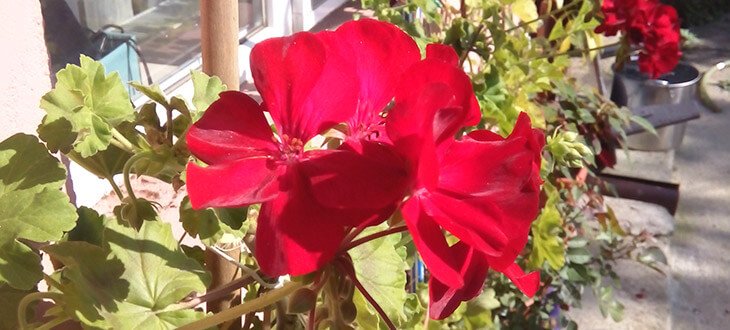6 Tips For Growing Better Geraniums
Geraniums are one of the most beloved and popular plants in the world thanks to their colorful-rich flowers, due to the fact that they are plants relatively easy to maintain, and because they can bloom all year round.
Even though these are commonly known as “geraniums”, the glaring large-flowered that most people grow around the house are actually pelargoniums.
For the sake of the simplicity, I’m just going to refer to these plants as “geraniums.”
The most popular and which I will talk about in this article is Pelargonium x hortorum. Pelargonium x hortorum can be found in a variety of colors and is usually found on the balconies of many houses.

Geraniums can grow very well in pots but can also be planted directly in the garden during the summer time.
There are a few species that can survive an easy frost, but if you want to enjoy these plants during the winter, you have to plant them in a flower pot, keep them indoors, and place them close to a window to receive enough light from the sun.
Since they don’t have a highly developed root system, these plants can grow in relatively small pots.
Besides their pleasing look, geraniums are known to repel mosquitoes and other insects with their distinctive smell.
Even though geraniums usually don’t require too much care, there are several things you need to know in order to grow healthy plants that produce beautiful flowers.
Here are several tips for growing healthy Geraniums.
Disclosure: This page contains affiliate links. This means that the owner of this website might be compensated for any qualifying purchases made via these links.
Contents
1. Give geraniums enough light and sun
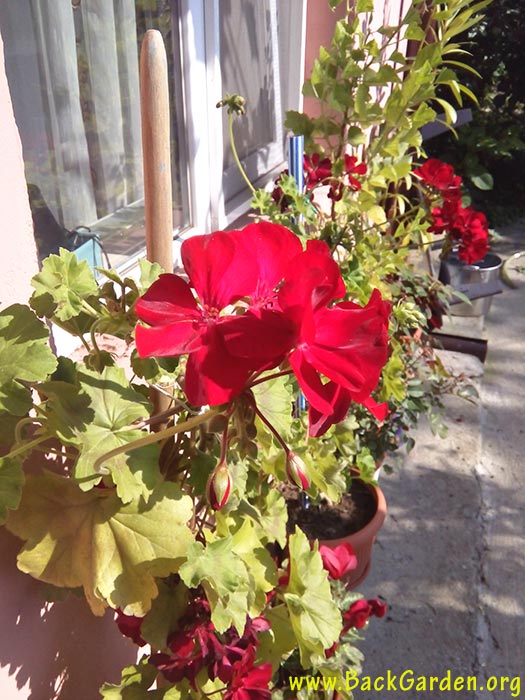
Geraniums are sun-loving flowers, but also plants that love open and well-ventilated spaces.
Can geraniums take full sun?
Geraniums should have between 4-6 hours per day of full sun, therefore, you shouldn’t leave the plants in full sun on a sunny day.
The optimal conditions for the common geraniums would be to give them full sun during the morning and light shade after noontime.
2. Do not water geraniums in excess
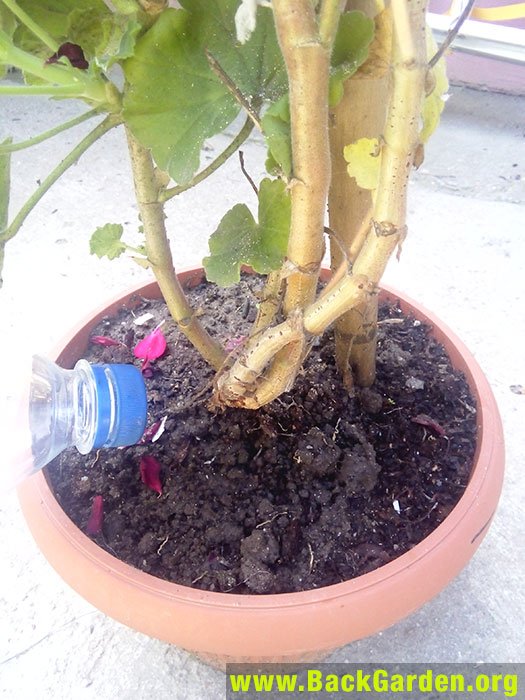
Geraniums can survive long periods of dry soil much better than long periods of growth in a soil that’s too wet.
In fact, one of the most frequent causes of death for geraniums is over-watering.
The yellow leaves of geraniums, usually mean that the plants suffer either from the lack of water or over-watering.
This type of plants prefer growing in humid, but well-draining soil. Hence, make sure that the containers of your plants allow the excess water to leak off the vessel.
You need to adapt your watering schedule based on how well the soil retains water, the period of the year, and other factors.
Remember that you only need to water your geraniums when the soil it’s dry.
If you find it hard to estimate the proper moisture level, it’s advisable to use a moisture meter (get one from Amazon).
Geraniums should be watered in the morning or in the evening, not during the noontime, or when it is very hot outside.
3. Feed geraniums with fertilizer
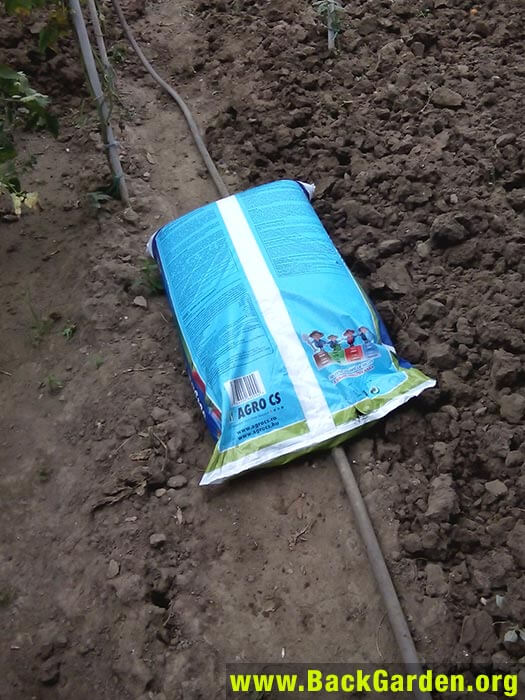
Geraniums, especially the potted plants which were planted in a nutrient-rich soil mix, have usually low fertilization requirements. Still, if you want your geranium plants to bloom all year round you should feed them with a good fertilizer.
Potted geraniums need fertilization once every 4-6 weeks during the spring and summer, and no more than every 8 weeks in the autumn and winter. Make sure you do not exaggerate with fertilizer. Otherwise, your plants will suffer as well.
The most popular and best fertilizers for geraniums are considered to be the water-soluble fertilizers (more about best fertilizer for geraniums here).
If you want to save some money and don’t want to buy fertilizer, you can make your own fertilizer for geraniums at home using the following ingredients.
Ingredients:
- 1 gallon of water
- 100 g of fresh yeast
- 1/2 cup of sugar
In a bowl, add the yeast in warm water and mix until the yeast is completely dissolved, then add the sugar.
Place a kitchen towel over the container and let it ferment.
When the fermentation process has ended, the solution obtained is ready for use. Add the fermented solution to 10 liters of water.
Water the flowers with this fertilizer once every 10 days during the spring or summer time.
This yeast fertilizer stimulates the microorganisms in the soil, increases the carbon level in the soil, and incites the plant growth.
4. Deadhead geraniums & remove yellow leaves
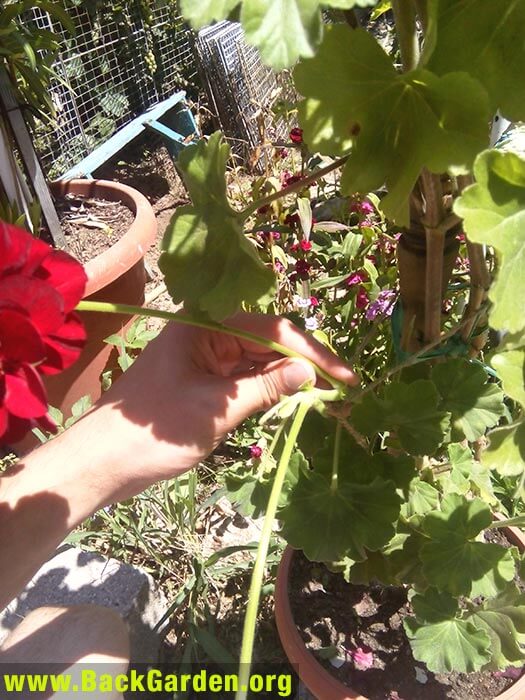
After the blooms of the plant start to turn brown, you need to perform what it’s called a “deadhead”.
This basically means removing the past blooms, but instead of just removing the top flowers, you need to cut off from the bottom of the stem that sustains the flowers.
After the withered blooms are removed, the plant can use the nutrients in the soil more efficiently to produce new flowers.
Another thing to do in order to keep your geraniums in a good shape is to remove the yellow leaves from the plant.
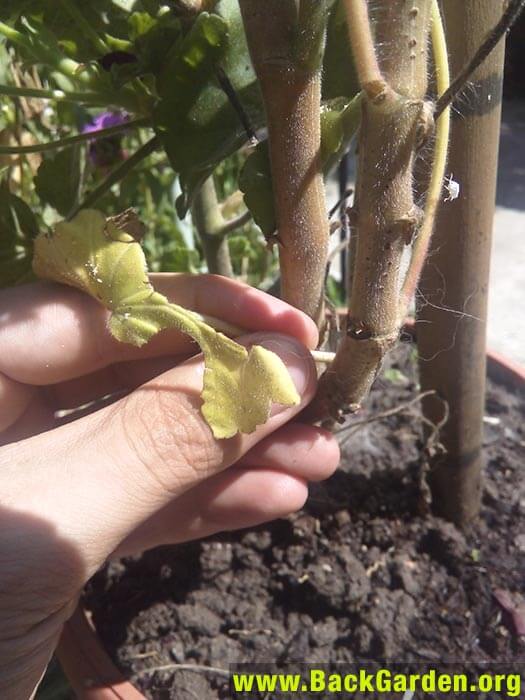
Some leaves (especially the ones at the bottom of the plant) usually turn yellow due to the lack of light, too little water, over-watering, or a plant disease.
Besides the bad look, if you don’t remove the affected leaves, in some cases, the condition might spread to other leaves as well.
5. Protect geraniums from pests

Caterpillars control
Caterpillars are one of the pests that can do the most damage to the geraniums.
Probably, the most efficient way to get rid of caterpillars is to hand pick them (I know, no one likes that, but it’s very efficient).
However, if you want to use a pesticide, you can buy a pesticide that contains Bacillus Thuricide, a naturally occurring bacteria that attacks the digestive system of caterpillars and worms after the bacteria is ingested by the host.
The pesticides based on Bacillus Thuricide it’s safe for pets and humans.
Aphids & Whiteflies control
A simple solution that you can make at home for controlling aphids is made from water and soap.
Ingredients:
- 1 gallon of water
- 1 tablespoon of organic soap
Spray the geraniums with the soap solution whenever you notice the presence of aphids on your plants.
6. Pinch your geraniums

If you want your geraniums to have a bushy look and not only a main stem, you need to pinch them.
Peaching consists in cutting off the tops of the plants when the plant is still young.
This will allow the plant to grow more ramifications from the side buds and your Geraniums will get that nice bushy look.
Conclusion
Even though geraniums do not require so much care and attention as other flowers, you need to know what these plants need for a healthy and vigorous growth.
I hope the tips presented in this article will help you to grow vibrant and healthy geraniums that will bloom all year long.

